
Features
Structural
Training
Back to basics: September 2010
The most difficult part of rescuing an unconscious victim from a building is to get him from the floor up to the window sill for extraction. Getting the victim to the window is a physically demanding job and causes considerable firefighter fatigue.
September 20, 2010
By Mark van der Feyst
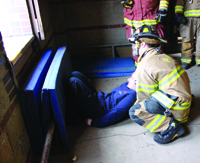 |
|
| Photo 1: Instructor Anthony Petruzzi from the Pittsburgh Bureau of Fire demonstrates the correct positioning of the victim by collapsing the victim’s legs and moving him close to the wall. |
|
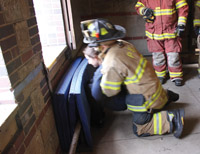 |
|
| Photo 2: The victim’s wrists are secured and his upper body is resting on the firefighter’s legs. |
|
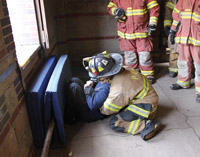 |
|
| Photo 3: The interior firefighter starts to lift the victim to the window. |
|
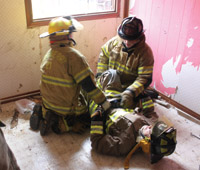 |
|
| Photo 4: Instructors Dave Mack and Tim Llewellyn position the victim against the wall. |
|
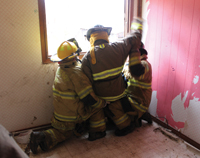 |
|
| Photo 5: The interior firefighters lift the victim up to rest him on their knees. |
|
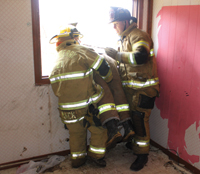 |
|
| Photo 6: The victim is ready for extraction. PHOTOS BY MARK VAN DER FEYST |
The most difficult part of rescuing an unconscious victim from a building is to get him from the floor up to the window sill for extraction. Getting the victim to the window is a physically demanding job and causes considerable firefighter fatigue. Factors such as size and weight of the victim, the strength of the firefighter(s), floor surface conditions, type of clothing on the victim, heat conditions and distance from location of the victim to the window can complicate the rescue. We will explore these factors in more detail in the November issue. Here, we will focus on removing the victim from the structure.
There are two ways to get an unconscious victim out of a building – a single-firefighter method and a two-firefighter method. Both techniques require familiarity, and whichever one you choose should be practised on the training ground before it is employed it in a real situation.
In the single-firefighter method, two firefighters search for the victim inside the building and bring him to the window. One firefighter remains in the building, lifting or positioning the victom at the windowsill. The other firefighter leaves the building, and gets on the ladder at the window, ready to receive the victim and bring him down to the ground. In photo 1, a firefighter positions a victim for extraction. This photo shows a fixed facility that has anchor bars just inside the window at the ground. For this training exercise, two blue gym mats were used to bring the wall out beyond the anchor bars. The wall is an important part of the single-firefighter method as it helps in the positioning and lifting of the victim. The interior firefighter has positioned the victim with his legs toward the window. The aim is to bring the victim as close to the window as possible to reduce the travel distance. This is accomplished by collapsing the victim’s legs, as shown in photo 1. This provides a pivot point for the victim’s body against the wall.
The interior firefighter then positions himself behind the victim and starts to raise the victim’s upper body by reaching underneath his armpits and grabbing the victim’s wrists. The firefighter then secures the victim’s wrists to ensure that he does not lose contact with the victim, as shown in photo 2. This also helps the interior firefighter with the lifting process.
Notice in photo 2 how the victim’s upper body is resting on the legs of the interior firefighter. The travel distance from the window sill or wall is decreased. From this point, all the interior firefighter has to do is lift the victim up and toward the window sill. This action requires considerable strength, and as it is so physically demanding that the firefighter really has only one opportunity to do this. Failing the first time will cause exhaustion and set up failure for the second and third attempts. Just as athletes train to execute certain strength moves like the clean and jerk or power clean with great and quick execution, the interior firefighter needs to execute this move properly and efficiently.
In photo 3, the interior firefighter begins to lift the victim to the window sill. This lifting position is awkward and requires the firefighter to lift with his legs, upper body and back. The receiving firefighter on the ladder can help by reaching in and grabbing a piece of the victim’s clothing or the arm of the interior firefighter’s bunker jacket. Either way, the victim will end up on the window sill with half of his body already out and ready for extraction.
For the two-firefighter method, both firefighters are inside the structure helping to lift the victim from the floor to the window. This may be necessary if the victim is too heavy to lift or if the firefighters are fatigued. Either way, having two firefighters makes the job easier. There is no firefighter waiting on the ladder to receive the victim unless you are operating with a three-person team, which is less common.
Similar to the single-firefighter method, the two firefighters position the victim with his feet facing the wall. The legs are collapsed against the wall to reduce the travel distance and provide a pivot point (see photo 4). Notice how the firefighters have one knee between the victim’s upper thigh and lower leg; this helps the firefighters lift up the victim onto his knees. The two firefighters then reach underneath the victim’s upper body with their arms, and lift the victim up and onto his knees (see photo 5).
Another variation involves tying a piece of webbing around the victim’s chest and using it as handle. The firefighter would put one arm underneath the victim’s upper body and use his other hand to grab and pull on the webbing. This allows for an easier lift. Once the victim is on the firefighters’ knees, the firefighters are able to position the victim onto the window sill and half way out the window. With a three-person team, the receiving firefighter on the ladder then takes over and positions the victim onto the ladder. With a two-person team, a firefighter needs to get on the ladder to remove the victim. This can be a difficult task, but a practical method is to have one interior firefighter climb over the victim to get on the ladder. Although this is unorthodox, it’s important to remember that getting the victim out of the building is the first priority.
Executing a victim removal with a ground ladder is a difficult and exhausting task that requires practise. Getting the victim from the floor to the window sill is an even more daunting task. Practice will help you build the confidence to execute the single- or two-firefighter removal method.
Mark van der Feyst is an 11-year veteran of the fire service. He works for the City of Woodstock Fire Department in Ontario. Mark is an instructor teaching in Canada, the United States and India. He is a local level suppression instructor for the Pennsylvania State Fire Academy, an instructor for the Justice Institute of British Columbia and a professor of fire science for Lambton College. E-mail him at Mark@FireStarTraining.com
Print this page